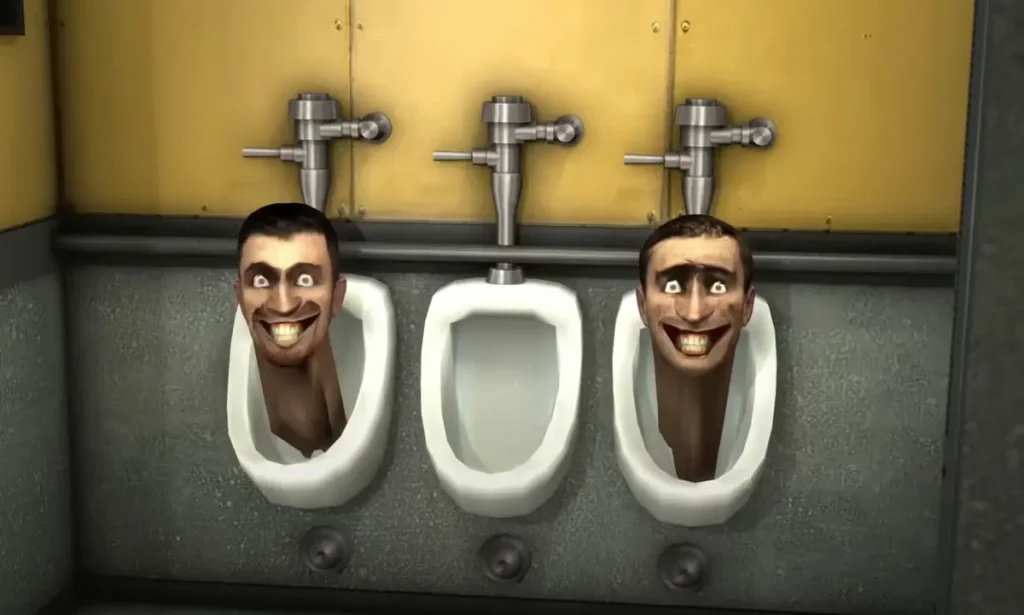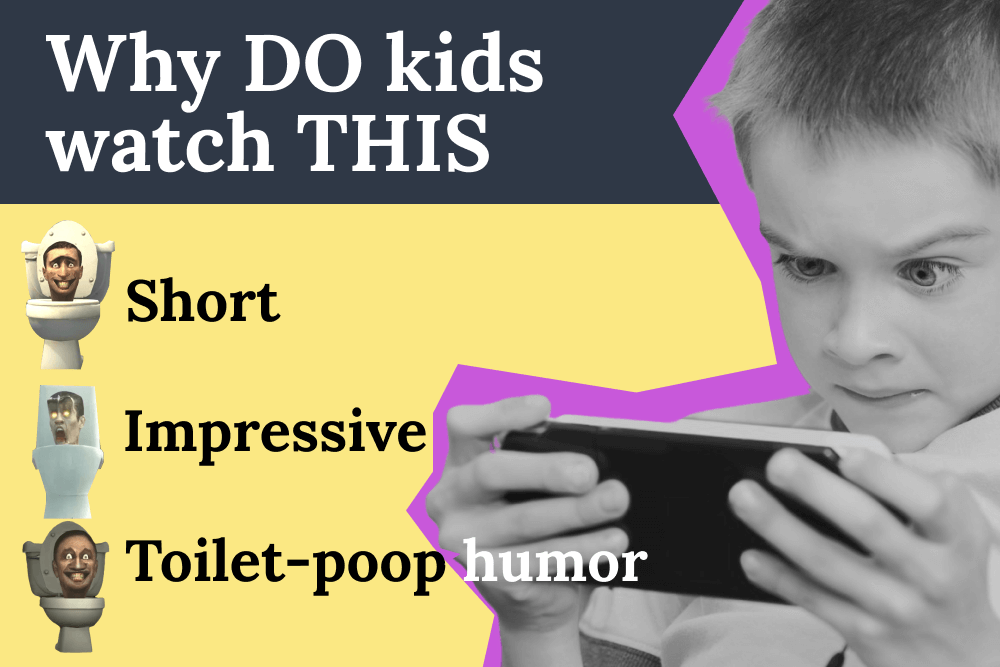Parent’s Handbook to Skibidi Toilet: Exploring Meaning and Impact

The skibidi toilet meaning is a hot topic for modern parents, as strange content that kids eagerly consume raises concerns. Various games and cartoons featuring ambiguous and downright surreal characters have become familiar to almost every child today. One such example is the creepy “Skibidi Toilet.” In this article, we will explore this phenomenon in-depth.
At first glance, there’s nothing inherently wrong or dangerous about having an affinity for something extravagant. However, sometimes this extravagance can be overwhelming, causing parents to genuinely worry about their children. Can watching such a series harm a young psyche? Why is “Skibidi Toilet” so popular among the younger generation? And what should you do if, as a parent, you feel the need to limit your child’s exposure to this type of content?
We spoke with child and adolescent psychologist Dr. Patricia Norton about how close familiarity with this character affects a child’s mind.
Contents:
- What is Skibidi Toilet and Who Created It?
- The World of Skibidi: What Else Is Out There?
- Why Do Kids Like Skibidi Toilet?
- My Child Loves Skibidi Toilet: How Will It Affect Their Mental Health?
- How to Protect Your Child from Scary Content
- Should Parents Worry About Skibidi Toilet?
- FAQs
What is Skibidi Toilet and Who Created It?

Credit: youtube.com/@DaFuqBoom
“Skibidi Toilet” is an animated series available on YouTube and YouTube Shorts, featured on the channel of user DaFuq!?Boom!, known in real life as Alexey Gerasimov. Alexey is a student at the Moscow People’s Friendship University (RUDN).
Alexey Gerasimov created the first video as a joke, but the clip, which was released in February 2023, went viral, prompting him to continue the series.
What is the Skibidi Toilet Series About? Show Background
The storyline centers on the conflict between the race of Skibidi Toilets and the so-called “Agents.” The Agents are depicted as characters in business suits with cameras, speakers, and televisions for heads—known as Cameramen, Speakermen, and TV-men, respectively. Their antagonists are portrayed as human-headed toilets, or toilets with heads sticking out, which have taken over the planet and are trying to turn everyone into similar beings. This simple conflict forms the basis of the series, linking together the short clips.
The episodes are presented as a kind of video chronicle, filmed from the first-person perspective of various Cameramen. Viewers watch the action unfold in different locations. To date, there are 72 episodes available on the channel, many of which are split into several short parts, each about 3-4 minutes long.
Over time, the universe has significantly developed. Among the Skibidi Toilets, there are individuals of different sizes and “configurations.” There are older and younger characters, some equipped with glasses and katanas. There are even Skibidi scientists, policemen, and Skibidi clones. Starting around episode 60, Astro Toilets were introduced. This special group is distinguished by their red eyes and ability to fly.
Meanwhile, the Agents’ army is also growing. For instance, a few episodes ago, Ghost or Spirit Agents were introduced. Fans of the series believe these are projections of Cameramen who died in previous episodes.
Why “Skibidi”?
The toilet reference in the title seems clear, but why “Skibidi?” The origins lie in the series’ musical accompaniment. There are no full-fledged dialogues in the clips—only occasional short phrases in the English language.
Despite this, the “toilet-headed” characters actively communicate with each other. Instead of regular speech, they use the phrase “Skibidi Dop Dop Dop Yes Yes” and dance. This line comes from a mashup of two tracks—”Give It to Me” by Timbaland (performed with Nelly Furtado and Justin Timberlake) and “Dom Dom Yes Yes” by Turkish artist Biser King. This mashup also serves as the main soundtrack for the series.
What is Skibidi Toilet Syndrome?
“Skibidi Toilet Syndrome” (or translated the Sindrom Skibidi Toilet) is a term that humorously refers to a phenomenon where children exhibit certain behaviors or reactions that are reminiscent of elements from the “Skibidi Toilet” series. This slang term is not a recognized medical condition but rather a playful way to describe situations where children display characteristics inspired by these animated videos.
For example, a child might develop a fascination with toilets, pretend to be a “Skibidi Toilet” character during playtime, or exhibit toilet humor in their conversations. While these behaviors are typically harmless and a normal part of childhood play and exploration, the term “Skibidi Toilet Syndrome” is used colloquially to describe them lightheartedly.
Is Skibidi Toilet Appropriate for Kids? Understanding the Age Rating

“Skibidi Toilet” is generally suitable for children aged 6 and above. It features colorful characters, catchy songs, and light-hearted humor that appeals to younger audiences. However, some scenes and themes may be more suitable for older children due to their understanding of humor and their ability to differentiate between fantasy and reality. Skibidi Toilet could be comparable to our well-known Scooby Doo cartoon series from when we were children.
Additionally, parents should consider their child’s sensitivity to certain content when deciding if “Skibidi Toilet” is appropriate for them. Overall, it’s essential to supervise younger children while they watch and discuss any questions or concerns they may have about the content.
The World of Skibidi: What Else Is Out There?
The Skibidi universe quickly became a hit among kids, leading to a surge of products related to the cartoon characters and theme. There are a wide range of popular items in the entertainment franchise that attentive parents should know about.
Game Mods

Credit: modbay.org/mods
Fans of the Skibidi universe have created special add-ons for video game series that allow beloved characters to be included. The most popular is a mod for Minecraft. This is likely because the game itself is very popular with children. The ability to combine two favorite fandoms and fan fiction stories probably excites them immensely.
With the mod, you can add the most popular types of Skibidi characters into the game world. They are rendered in the typical pixelated style of Minecraft. Players essentially take on the role of the Cameramen, with antagonists chasing your character just like in the Skibidi Toilet series.
Figurines and Toys

Credit: ebay.com
These creepy characters have made their way into the real world as well. Skibidi characters and Agents have become part of children’s offline play. You can find entire sets of plastic figurines on marketplaces. Additionally, there are plush and even rubber toys, mainly in the form of the Skibidi Toilets. Cameramen and Speakermen are less commonly found online.
T-Shirts and Accessories

Credit: aliexpress.com/
Fans can also express their love for Alexey Gerasimov’s viral videos through their appearance. For instance, you can buy a T-shirt featuring a portrait of one of the characters. You can easily find keychains, socks, and caps with similar images to complete the look.
Simple Skibidi Toilet’s Games

Credit: crazygames.com/game/skibidi-online
For those who want to interact with the “singing toilets” themselves, there are numerous games available. These are mostly flash games that can be played online by internet users on special websites without needing to download anything to a PC or phone.
These games are generally simple. For example, clicker games where the goal is to continuously click on the screen. You can also find simple racing and shooting games.
Skibidi Toilet Feature Production
Variety reported that former president of movie production company Paramount Pictures, Adam Goodman, and director Michael Bay are in talks of producing a long-form feature of “Skibidi Toilets.”
Why Do Kids Like Skibidi Toilet?

Many parents ask this question when they first see an episode. Indeed, for adults, what happens on the screen may seem bizarre. Creepy, unrealistic monsters, worrisome actions, unnatural graphics, and an almost complete lack of plot fail to spark much interest. In essence, adults likely see the series as “brain rot” for their kids.
However, it’s important to remember that children’s perception of reality is very different from that of adults. A highly simplified plot is much easier for young children to understand. Moreover, the abundance of action scenes compensates for the lack of serious plot development.
Additionally, preschool and early elementary-aged children are highly receptive to what is known as “toilet humor.” They are thrilled by the mere presence of toilet characters in the series. The sight of human heads sticking out, resembling someone stuck in a porcelain bowl, raises the comedic level immensely. To defeat such an enemy, you must touch on the toilet theme again by pressing the flush button.
In summary, the main elements of Skibidi Toilet’s success are:
- Numerous action-packed battle scenes.
- Visual effects.
- Short episode durations.
- Toilet-related humor.
These are simple yet effective ways to capture and hold a child’s attention.
‘Skibidi Toilet’ leverages all the main features of a child’s mind: short clips, toilets as main characters, creepy images, and catchy music. Unfortunately, such content becomes addictive and, as a result, popular. It’s easier to watch ‘brain candy’ than intellectually stimulating content.
The rapid scene changes, shooting, explosions, and jump scares captivate young minds and make them watch the clips repeatedly. Creators and some internet analysts see deep meanings in this series, but these aren’t apparent during viewing unless you specifically look for them.
According to Tubefilter, DaFuq!?Boom! ranked among the top 50 most-viewed channels on YouTube at the end of last year. Children worldwide eagerly watch the series—in June 2023, it became the most-viewed channel in the United States.
Interestingly, while younger children seem enamored by the series, older kids and teens often dismiss it as juvenile or cringe-worthy:
- “My 13-year-old calls it ‘baby content’ and refuses to watch it, but my 8-year-old can’t get enough of it.” — Reddit Discussion
- “It’s the kind of thing only younger kids find funny. My teenager just rolls her eyes every time her little brother watches it.” — Parent on Twitter
- “I doubt anyone over the age of 10 would enjoy this; the effects and everything make me cringe.” — Reddit
My Child Loves Skibidi Toilet: How Will It Affect Their Mental Health?

Many parents feel anxious when they notice their child’s interest in internet culture promoting surreal games or cartoons. The appearance and actions of characters might seem unhealthy—could this impact a young child’s developing psyche? Will the series of editorial cartoons lead to a generation of twisted children?
A common mistake parents of preschoolers make is not monitoring the content their children consume. At this age, it’s crucial to instill taste and lay the foundation for critical thinking, because as the child grows older, parents will have less influence.Therefore, it is essential to discuss with your child what captures their attention, especially when it comes to questionable content like ‘Skibidi Toilet.’
Ask what your child likes about the cartoon and explain what you don’t like. Ask what the episode was about. Highlight the absurdity of the events. If possible, delay exposure to such content for as long as possible.
Fear of Using the Toilet

Parents’ concerns often take a more specific form. Various forums have numerous posts about children having issues using the bathroom after watching Skibidi Toilet. For instance, some users report that their children refuse to transition from the potty to the toilet, fearing a sinister head will pop out. There are also posts about older children avoiding public restrooms and mobile toilets altogether, causing uncomfortable situations.
One concerned parent on Reddit shares, “We recently started potty training and he refuses to use the toilet now due to skibidi toilet. Whenever we try to put him on it he screams and refuses to go anywhere near it. We’ve tried explaining that Skibidi Toilet isn’t real and our toilet is completely safe, but it seems like it’s too overwhelming for him.”
However, it’s important to recognize that information on the internet, especially on forums, can be unreliable. Some of these stories might be true, but even then, we can’t be sure of the author’s objectivity. The poster might exaggerate, misunderstand the child’s explanations, or approach the situation with bias, perhaps already viewing the series as causing harm to children and attributing the child’s reluctance to use a public toilet to fear of the character. But it might turn out that the child simply encountered a dirty toilet or a bad smell and didn’t want to use it for that reason.
Children often refused to use public restrooms even before this series existed. Moreover, there are developmental stages where a child regresses and refuses to use the adult toilet. But if a child specifically mentions fearing a head in the toilet, address this fear, suggest ways to overcome it, and definitely restrict access to Skibidi Toilet content.
This situation is reminiscent of the Huggy Wuggy toy—a fun toy for many, but a nightmare for sensitive children.
If your child experiences a similar situation, employ critical thinking. Don’t rush to blame the cartoon; discuss the situation with your child and seek alternatives. For instance, offer to wait outside the stall (if possible) or find a bathroom on another floor of the building.
For parents, such a fear can be a real headache. Before leaving the house, discuss with your child that they might need to use a public restroom. Ask what specifically bothers them: are they afraid of the head, uncomfortable with the smell and dirt, or annoyed by having to remove many layers of clothing (especially relevant in winter).
Think of ways to address these concerns—bring wipes or disposable seat covers to reduce contact with dirt, cover their nose with a handkerchief scented with mom’s perfume to mask the toilet smell. If the child fears the head in the toilet, let them flush first while you stand by.
After using the restroom, be sure to praise your child and ask about their experience. It’s important to gradually reinforce a positive attitude toward using the toilet outside the home.
Other Parental Concerns

De Visu/Shutterstock.com
Below are some concerns raised by parents, gathered from discussions on Reddit and other platforms:
Content Appropriateness
One parent was alarmed to discover that their child had been watching “Skibidi Toilet” at preschool, which led them to withdraw their child from the school. They remarked, “I was horrified after discovering my 3-year-old was shown these viral videos at preschool. They didn’t even consult us, the parents. This is not the kind of content I want my child exposed to at such a young age.”
Addictive Viewing and Behavioral Influence
The series’ catchy music and episodic format make it highly engaging, but some parents feel it borders on addictive behavior:
- a concerned father questioned the series’ impact on his son’s behavior, asking, “Is my son in a Skibidi Toilet cult? I’m genuinely concerned about the impact it might be having on Alex’s life. It feels like it hypnotizes my son. He hums the songs from these videos even when he’s playing or eating. It’s starting to get on my nerves.”
- “My son watches episode after episode without stopping. I had to put a limit on how much he can watch because it’s all he talks about now.” — Parent on Reddit
- “It’s not just watching the show—it’s the way it takes over their playtime. My kids are constantly re-enacting scenes or singing the theme song.” — Facebook Comment
Peer Interaction
On the other hand, some parents have noticed that the series helps children bond with their peers. They shared, “My 6-year-old used the ‘Skibidi Toilet’ meme song on our vacation last week as a conversation starter with other kids. Turns out they all also knew it.”
Is Skibidi Toilet Bad for Kids? A Psychologist’s Perspective on the Web Series
Plunged into the Skibidi multiverse and watched all the episodes of the web series to form opinion:
Toilet humor is normal for preschool-aged children. Therefore, using a toilet as the basis for a character isn’t something I criticize. What concerns me more is the head with an unnatural smile and distorted facial features. Such depictions—something otherworldly and eerie—elicit feelings of aversion. These images are frightening and memorable because they tap into a primal instinct: “Something is wrong with this person, I need to be cautious and stay away.”

Reduced Attention Span
Due to the nature of the short-form content of Skibidi Toilet, it can effectively play a part in reducing the attention span of young adults and children. While Skibidi Toilet is not solely to blame as much of the content consumed on social media, such as TikTok and Instagram Reels, is just seconds long, it is a contributor. As your teen or child scrolls through short-form video content, they are hit with a release of dopamine, the chemical that promotes happiness and satisfaction. However, receiving these dopamine hits from short-form online content can leave an overall negative effect, inducing fake happiness.
In aspects such as paying attention in class or reviewing complex material, teens are starting to lose their focus because they are not getting instant gratification, and dopamine hits as they would scrolling on their phones. Expert Gloria Mark, PhD, stated in an interview that, in general, our attention spans when using a screen have decreased from an average of two and a half minutes in 2004 to just 47 seconds within the last five years.
Impact on Emotional Regulation
The vast number of jump scares, violence, and gruesome deaths (explosions, decapitations, dismemberments) is not appropriate for children and can provoke strong emotions and distress in sensitive individuals. Essentially, we are witnessing a horrifying war involving an army of toilets from a first-person perspective and repeatedly experiencing death—almost every episode ends with the death of the cameraman, through whose eyes we see the events unfold.
Social Isolation
When teens and children spend most of their time online, they can become victims of social isolation. The more invested they are in series like Skibidi Toilet, the more their humor will mold to inappropriate phrases and references that cannot translate into the real world. Spending so much time online and reducing face-to-face interactions with friends or teammates can cause social anxiety and an inability to read important social cues.
Controversy Attracts Attention
In my view, the series is simply a “hype” phenomenon—it carries no artistic or educational value. However, if your children are already familiar with these videos, it’s better for parents to form their own opinions about Skibidi Toilet. It’s important to try to stay calm and to prohibit such content rationally, without excessive emotion. Remember, forbidden fruit is sweet, and your emotional reaction signals to the child that there’s something very intriguing.
“It was initially appealing to young people for its utter weirdness,” says Danah Boyd, a partner researcher at Microsoft Research. “Parents (and many other adults) probably reacted with revulsion, as they’ve done many other times. That revulsion from adults makes it even more appealing to young people.”
Let me share a personal experience: I first learned about Skibidi Toilets from my own child. We had many conversations about what this series is about, whether it brings any value, and whether he genuinely likes the song or finds it just catchy. We discussed the quality of the graphics and the importance of storylines. Yes, at six years old, these are complex topics for both the child and the mother (it’s necessary to find formulations that are understandable to a young child), but I see how these long and deep conversations are paying off—my son is increasingly choosing quality cartoons over YouTube videos!
How to Protect Your Child from Scary Content
In some cases, restricting your child’s access to distressing content is the best solution. However, completely cutting off internet access isn’t the best approach. A better compromise is selective restriction.
For very young children, joint internet surfing works well. Don’t let your little one use a phone unsupervised and keep a close eye on what they encounter. However, if your child is already in preschool, this method becomes less appropriate.
Teach children from a young age to differentiate between quality art and ‘junk’ and to see different levels and subtexts in the information they receive. The best way to achieve this is by discussing what they read and watch.
Start by asking your child who the main character is, what they did, and who helped or hindered them. Ask your son or daughter their opinion—did the hero act correctly, and what can be learned from their example? Gradually, you’ll move to the question, ‘What did the author want to say?’ which will help uncover manipulations and marketing tricks. This way, your child will gradually learn to critically assess the information presented to them—an excellent defense against many real and online dangers.
You can also block specific accounts that spread unsafe content. However, be prepared for painstaking manual work, and even then, there’s no guarantee—similar materials can be posted from many accounts.
Therefore, the most convenient and effective option is parental control apps. Simplified versions of such programs are often already available on mobile phones and computers.
Specially installed applications offer a flexible set of options. For example, Kids360 not only filters out violent and sexualized content. The app allows you to regulate the amount of time your child spends on their phone. Parents can specify how much time can be spent on each app. For example, from two hours of daily access, you might allow 30 minutes for YouTube, 30 minutes for a favorite game, and the remaining hour for messaging friends and family. And if your child is in school, Kids360 can be set up so that mobile entertainment doesn’t distract them from their studies.
additionally, the app helps instill independence in your child. Parents can leave a list of tasks in the Kids360 app, and completing these tasks can be rewarded with extra screen time.
Should Parents Worry About Skibidi Toilet?

Credit: youtube.com/@DaFuqBoom
Don’t panic prematurely. In most cases, children’s psyches can handle this kind of content. The Skibidi Toilet multiverse often amuses and impresses kids more than it scares them. Young viewers of Generation Alpha enjoy the specific toilet humor and the spectacular battle scenes. However, if you know that your child is very impressionable and prone to anxiety, take action—but do so carefully.
FAQs
What does Skibidi Toilet mean in slang?
While “skibidi toilet” has no meaning in slang as it is a television show, the term “skibidi” is often heard by 9-year-old slang users, which means “good or cool” but also “bad or evil.”
What does Skibidi Toilet rizz mean?
The slang term “rizz” can mean multiple things, such as “good, bad, cool, or dumb.” When used along with Skibidi Toilet, it could mean that the latest episode was cool or dumb based on the child’s opinion.
What’s the deal with Skibidi Toilets?
For mysterious reasons, children tend to really enjoy watching the Skibidi Toilets Youtube Shorts. It could be due to the fact that toilet humor is well perceived and appreciated by younger children or the interesting cartoon graphics. Nevertheless, Skibidi Toilets looks like it is around to stay and something parents should be aware of when their children are watching internet videos.
Does Skibidi mean anything?
“Skibidi” in itself is a slang term. It can mean “good or cool” but also “bad or evil.” It is an adjective or exclamation that kids in Generation Alpha often use amongst their friends.
Проверьте электронный ящик





















